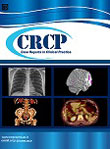فهرست مطالب

Case Reports in Clinical Practice
Volume:1 Issue: 1, Winter 2016
- تاریخ انتشار: 1394/12/20
- تعداد عناوین: 9
-
-
Pages 1-3A 53-year-old obese woman with history of obsessive compulsive disorder was referred to the general internal medicine clinic because of erythroderma and progressive dyspnea. Tapering psychiatric drugs and administering corticosteroids did not help her. A mild exudative pleural effusion and solid/cystic large ovarian masses were found in work-ups. The pathology of the masses was indicative of high-grade serous adenocarcinoma of ovaries. Five months after surgery and chemotherapies, her erythroderma resolved, confirming the diagnosis of paraneoplasric erythroderma due to ovarian cancer.Keywords: Ovarian cancer, Erythroderma, Paraneoplastic syndrome
-
Pages 4-6A 40-year-old woman visited our emergency department due to a 3-day history of headache. She was found to have deep cerebral vein thrombosis, which was worsened after initiation of heparin treatment. We present her as the only reported case of unilateral thalamic and basal ganglia edema in the setting of deep vein thrombosis secondary to bacterial meningitis.Keywords: Meningitis, Basal ganglia, Cerebral deep venous thrombosis, Thalamus
-
Pages 7-10Primary hyperparathyroidism usually presents with renal, gastrointestinal, mental and skeletal signs and symptoms. Brown tumor is a benign lesion that arises as a direct result of parathyroid hormone on bone tissue in some patients with hyperparathyroidism. Multiple brown tumors may simulate a malignant neoplasm and it is a real challenge for the clinicians in the differential diagnoses. Here, we present a 68-year-old man with multiple lytic lesions in pelvis bones, highly suspicious for metastatic malignancy that finally we found that the patient had primary hyperparathyroidism.Keywords: hyperparathyroidism, Brown tumor
-
Pages 11-14Hashimoto encephalopathy is an autoimmune disease characterized by an increase in antithyroid antibodies in the serum of patients with multiple neuropsychological symptoms. We report a case with lower level of antibody and fairly response to corticosteroid; however, clinical presentation, brain magnetic resonance imaging findings and the negative results of other diseases confirmed Hashimoto encephalopathy diagnosis. First, a relatively good corticosteroid response was seen but after one weak, the patient withdrew her drug and got back with a corticosteroid resistant progressive attack one month later. Our case had a mild increase in antithyroid antibodies and pure sensory polyneuropathy and did not show significant response to corticosteroid therapy. Can antithyroid antibodies titers be a marker of corticosteroid treatment response? this should be investigated in the future studies.Keywords: Antithyroid antibody, Hashimoto encephalopathy, Polyneuropathy
-
Pages 15-18Salivary gland choristoma of the middle ear is a rare mass characterized by the presence of normal salivary gland tissue in the middle ear cavity. This mass is usually accompanied with ossicular chain and facial nerve anomalies. Total surgical excision is a treatment of choice if the facial nerve is intact. Here, we describe a case of salivary gland choristoma of the middle ear, and discuss our experience. Our patient was a 41-year-old man presented with 6 months history of hearing loss. Intra-operatively, we detected a soft, pinkish mass with evidence of ossicular chain malformation. Patient showed hearing development in following up after three months.Keywords: Salivary gland choristoma, Middle ear mass, Hearing loss, Ossicular chain malformation
-
Pages 19-21The prevalence of placenta percreta in early stage of pregnancy is very infrequent; nevertheless, it is known as a life-threatening complication. In this report, we introduce a case of massive intra-abdominal hemorrhage associated with placenta percreta and uterine rupture. A 35-year-old woman, gravid 3 para 1, with a previous Cesarean section and complete mole, underwent suction and curettage. She was admitted to emergency department for acute abdominal pain, massive intra-abdominal bleeding and hypovolemic shock. An urgent laparotomy and hysterectomy was performed after resuscitation procedures applied. Uterus-saving procedure was impossible; the middle part of uterus had a perforation in size of 5 millimeters. The patient was discharged on the 4th following day in a stable condition. The pathologic report was placenta accreta.Keywords: Uterine rupture during pregnancy, Second trimester, Hydatidiform mole, Suction, curettage, Bell's palsy
-
Pages 22-24A man with a history of urothelial carcinoma is presented here. According to investigations, he had bilateral hydronephrosis due to the pressure effect of a large mass in his bladder. The patient underwent surgical procedure including mass resection and ureter reimplantation. The final pathology report was only fat necrosis.Keywords: Urothelial carcinoma, Fat necrosis, Bladder tumor, Pseudotumor
-
Pages 25-27Leptospirosis is a common zoonotic infection in human caused by spirochete Leptospira. The disease is often underdiagnosed because of the difficulties in its clinical diagnosis and lack of suitable confirmatory laboratory tests. In this case report, we describe a case which highlights the importance of considering leptospirosis as the diagnostic possibility with hepatic, renal, and hematologic system involvement particularly where diagnostic support and resource are limited.Keywords: Leptospirosis, Weil disease, Zoonotic disease
-
Pages 28-29

